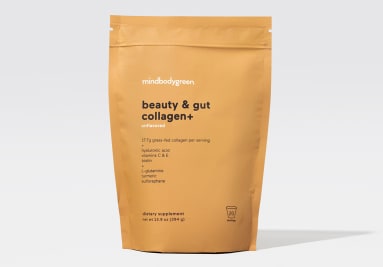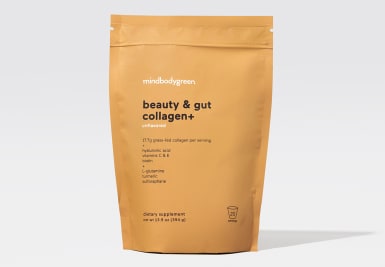Hyaluronic Acid: 6 Skin & Health Benefits + How To Get More


This much-loved skin care ingredient is a compound our bodies make on their own that boasts all kinds of potential health benefits—far outside of the skin, like supporting our joints to even eye health.
Here's everything you need to know about hyaluronic acid, what it does for the body, and how to get more of it.
What is hyaluronic acid?
Hyaluronic acid, also known as HA or hyaluronan1, is a compound similar to collagen created by the human body that serves several important functions.
It is the key molecule involved in skin moisture1, meaning it plays a huge role in the skin's aging process, which is why you'll hear it discussed with skin care and topicals most often.
In fact, 50% of the body's total HA is in the skin2. But it's also present in every tissue and fluid in the body.
It's a key ingredient in synovial fluid3, which keeps our joints limber and well lubricated. It's what gives eyes their unique reflective quality and round shape. It can be found in the umbilical cord during pregnancy and birth.
Hyaluronic acid works by drawing in water and holding it—up to 1,000 times its weight, making it an incredibly effective and hardworking molecule.
“Hyaluronic acid is a naturally occurring type of sugar that is produced by the body and found in the highest concentrations in our skin, connective tissue, and eyes,” says board-certified dermatologist Jennifer Chwalek, M.D. “It functions to retain water, keep our tissues well lubricated, and our skin looking firm and youthful. It also helps to speed up wound healing by regulating inflammation levels and blood vessel formation, and can increase collagen production, which is another way it can help our skin as we age.”
Summary
6 ways hyaluronic acid supports the skin and body:
1. It keeps skin hydrated
Hyaluronic acid's most significant benefit for the skin is hydration. That may not seem like a lot on its own, but hydration is the key element in so many aspects of healthy, glowing skin.
Well-hydrated skin is more elastic and supple. Because hyaluronic acid can hold an impressive 1,000 times its own weight in water2, it's one of our body's best defenses against dehydrated skin.
"It draws water into the stratum corneum, the top layer of the skin. It is a humectant, so it gives an immediate improvement in the way the skin looks—less ashy, dry, dull," says holistic dermatologist Cybele Fishman M.D, assistant clinical professor at Mount Sinai.
2. It keeps skin looking youthful
The reason people's skin is more resilient and pliable when they are younger is that youthful skin has a high water content.
HA, which is unique in its capacity for binding and retaining water, is the key molecule responsible for keeping skin naturally hydrated2.
Over time, our skin loses some of its ability to retain moisture, both because of external factors (like how much exposure we have to sunlight) and internal factors (like the body's natural tendency to produce fewer sex hormones as we age).
3. It helps our bodies heal
In addition to being present in just about every imaginable part of the body and responsible for keeping skin looking healthy and hydrated, HA is integral to our body's healing process2.
When we're hurt, our bodies actually produce more hyaluronic acid, the synthesis of which increases during tissue injury and wound healing4. What's more, HA is responsible for regulating a lot of what happens when the human body goes into tissue repair mode, including activating inflammatory cells.
4. It may help our joints feel more lubricated
As noted above, hyaluronic acid is present in many places in the body. One place of note is the bones and joints. Research is finding that it plays a key role in helping joints feel lubricated5, potentially supporting joint health as we age.
One double-blind, placebo-controlled study found that older patients taking it in supplement form had less knee pain6 over a 12-month time period.
5. It may help symptoms of dry eyes
As hyaluronic acid is present in our eyes naturally, it makes sense that it can help relieve dryness. When applied via drops (at upward of 0.4%), it can help eyes feel more hydrated7.
6. It may help acid reflux
Multiple studies have found that when combined with chondroitin sulfate8, it can help symptoms of acid reflux, as it can help protect the esophagus9 and help it heal from the damage10 caused by the acid.
Summary
What depletes hyaluronic acid in the body?
1. It naturally fades with time
According to Nigma Talib, N.D., a naturopathic doctor, our body's natural reserve of HA diminishes11 greatly over time. She says that by the time we reach our 40s, we have just 50% of the HA we had during our younger days.
That drastic drop is why many people also notice physical signs of aging in their 40s as well, like an increase in fine lines and wrinkles for some and increasingly dry and dull skin.
2. Sun exposure
While we all lose hyaluronic acid with time, there are external factors that lead to a quicker depletion of the miraculous molecule—most notably, how much time we spent in tanning beds or exposing our unprotected skin to the sun.
Approximately 80% of facial skin aging2 can be attributed to UV-exposure, which is worth keeping in mind the next time you think about leaving the house without applying sunscreen.
UV exposure burns through your natural reserve of HA2 in a tricky but very logical way. Initial UV damage actually causes an increase of dermal hyaluronic acid.
The mild wound caused by the damage triggers the body to send more HA to the epidermis. That's why, especially for young people, a tan can look so healthy and glowing.
This damage doesn't take long; in studies, as little as five minutes of exposure leads to increased HA in mice, proving that sun damage happens incredibly quickly.
Our bodies interpret burns (which includes tanning) as a wound, however, and over time, UV exposure leads to a different kind of wound-healing response—one that triggers the body to deposit scarlike type I collagen rather than the HA and collagen mixtures that make skin look more resilient.
Summary
How can you get more hyaluronic acid naturally?
Here's the good news: Even though your body does lose natural hyaluronic acid over time, you can replenish your HA with the help of both topical treatments and ingestible supplements.
Supplements.
Recently, companies have started adding the ingredient to their supplements, usually as a complementary active to other ingredients like collagen.*
Oral forms of HA have also been shown to support skin hydration12 and appearance. They have also been studied as a remedy for other conditions like osteoarthritis.*
The available evidence suggests that oral HA supplements are absorbed in the digestive tract and then migrate to the connective tissues13 that are most in need of more HA.*
Topicals
If you're concerned primarily about HA's effects on your skin, incorporate a topical solution. Topical hyaluronic acid acts as a powerful moisturizer.
Studies of topical HA products14 have shown that use for as little as two weeks can result in skin that's more hydrated, softer, and more elastic than skin not treated with topical HA.
Hyaluronic acid is the active ingredient in a number of serums, creams, and face masks. HA-infused products are also available at a number of different price points to fit any budget.
Plus, it's universally tolerable: "There's not a person who can't benefit from this ingredient," says holistic esthetician Amity Spiegel.
Summary
The takeaway
Hyaluronic acid is more than just a skin care trend. It's a naturally occurring molecule in the body that helps with hydration and healing across the board.
HA is responsible for keeping skin hydrated, glowy, and elastic. It's also a key ingredient in the synovial fluid that cushions our joints and in the gel-like substance that gives our eyes their shape.
The body's reserve of HA naturally depletes over time, and increased exposure to UV rays hastens its breakdown. Luckily, you can support your HA reserves with topical solutions, like serums and creams, and oral supplements.*
Editor's Note: This article was originally published on August 30, 2018. A previous version of this article indicated that holistic dermatologist Cybele Fishman M.D., was a clinical professor at Mount Sinai. We have since clarified this statement to indicate that Fishman is an assistant clinical professor.

Kayleigh Roberts is a freelance writer and editor living in Los Angeles, California. She earned a B.S. from the Medill School of Journalism at Northwestern University. She covers culture, entertainment, and health and has written for several notable publications including Elle, Marie Claire, and The Atlantic.
14 Sources
- https://www.ncbi.nlm.nih.gov/pmc/articles/PMC8347214/
- https://www.ncbi.nlm.nih.gov/pmc/articles/PMC3583886/
- https://www.ncbi.nlm.nih.gov/pmc/articles/PMC6603175/
- https://www.sciencedirect.com/science/article/abs/pii/S0144861720305385?via%3Dihub
- https://www.ncbi.nlm.nih.gov/pmc/articles/PMC7149899/
- https://www.ncbi.nlm.nih.gov/pubmed/23226979/
- https://www.ncbi.nlm.nih.gov/pmc/articles/PMC7915152/
- https://www.ncbi.nlm.nih.gov/pubmed/24379055
- https://www.ncbi.nlm.nih.gov/pmc/articles/PMC5347926/
- https://www.ncbi.nlm.nih.gov/pmc/articles/PMC3387832/
- https://www.jaad.org/article/S0190-9622(16)00202-4/fulltext#:~:text=The%20skin's%20hyaluronic%20acid%20(HA,of%20fine%20lines%20and%20wrinkles.
- https://www.ncbi.nlm.nih.gov/pmc/articles/PMC5522662/
- https://www.ncbi.nlm.nih.gov/pubmed/18959406
- https://www.ncbi.nlm.nih.gov/pmc/articles/PMC3970829/

